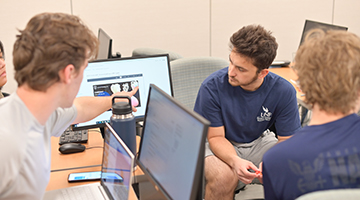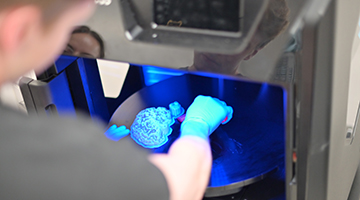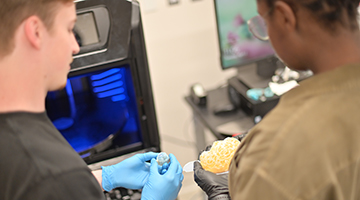UNF and Mayo Clinic collaborate on innovative 3D anatomy printing course
 The University of North Florida has teamed up with the 3D Anatomic Modeling Laboratory at Mayo Clinic in Florida to create an innovative undergraduate course at UNF.
The University of North Florida has teamed up with the 3D Anatomic Modeling Laboratory at Mayo Clinic in Florida to create an innovative undergraduate course at UNF.
The course gives biology and engineering students hands-on experience in an emerging field that will help improve patient outcomes. It will also prepare students with highly in-demand skills to work in 3D medical printing labs.
A few years ago, Dr. Robert Pooley, medical physicist at the 3D Anatomic Modeling Laboratory, helped conduct Mayo Clinic’s national job search for a software engineer in the lab and couldn’t find anyone with the exact qualifications needed.
Around the same time, Dr. Laura Habegger, UNF biology assistant professor, was looking for a way to teach her students advanced anatomic modeling.
The two scientists met during a UNF event and collaborated to create the framework for an innovative interdisciplinary course that launched with support from UNF MedNexus. This course will help fill a crucial gap in advanced medical printing skills and prepare students to enter careers with medical centers like Mayo Clinic and private medical equipment suppliers.
“This educational collaboration with Mayo Clinic is a perfect example of UNF responding to evolving talent needs in our community,” said UNF President Moez Limayem. “We are addressing a growing demand in medicine, while our students are gaining incredible experience in this cutting-edge field.”
 For the unique course that began this spring, Mayo Clinic selects tomographic imaging from unique medical cases and removes all patient identifiers to anonymize the scans. The data is then provided to students, who work together to interpret the CT and MRI data and convert the images into 3D models, such as a heart with a tumor or a brain with complex nerve damage. The students then fabricate the exact size and layers of the organs by 3D printing to include the specific medical issues for examination.
For the unique course that began this spring, Mayo Clinic selects tomographic imaging from unique medical cases and removes all patient identifiers to anonymize the scans. The data is then provided to students, who work together to interpret the CT and MRI data and convert the images into 3D models, such as a heart with a tumor or a brain with complex nerve damage. The students then fabricate the exact size and layers of the organs by 3D printing to include the specific medical issues for examination.
By combining Mayo Clinic’s imaging with the UNF advanced manufacturing program’s 3D printing resources, students taking the revolutionary UNF 3D Anatomy course are producing some of the most advanced, realistic and life-size models possible.
 Using 3D printing for the creation of physical replicas of anatomical structures that are impacted by specific unique or complicated conditions is revolutionizing medical care and allowing doctors and researchers to improve surgical procedures, create better treatment plans and reduce costs. 3D models play a significant role in healthcare education and are used by practitioners around the world, including Mayo Clinic's medical students, residents, fellows and experienced surgeons.
Using 3D printing for the creation of physical replicas of anatomical structures that are impacted by specific unique or complicated conditions is revolutionizing medical care and allowing doctors and researchers to improve surgical procedures, create better treatment plans and reduce costs. 3D models play a significant role in healthcare education and are used by practitioners around the world, including Mayo Clinic's medical students, residents, fellows and experienced surgeons.
Habegger is co-teaching the course with Dr. Grant Bevill, mechanical engineering associate professor, along with assistance from Dr. Pooley and Carleigh Eagle with Mayo Clinic and UNF graduate student Molly Dobrow.
Habegger and Pooley know of no other similar course offered by a university in the United States.
“We are the first known collegiate program that is introducing the field of anatomical 3D modeling and printing to undergraduate engineering and biology students,” said Habegger. “Combined with the support of Mayo Clinic’s top researchers, this course offers such a valuable, unique experience for our students.”
Watch highlights of the 3D anatomy printing course, only available at UNF.
